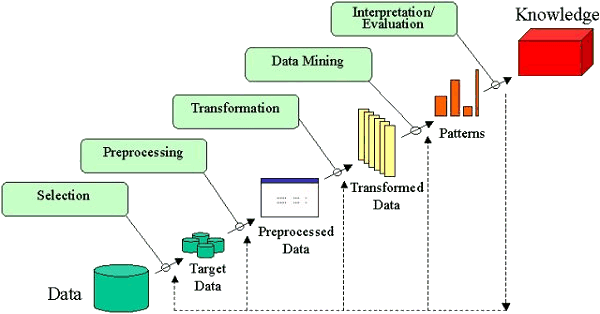Reference: Fayyad, Piatetsky-Shapiro, Smyth, "From Data Mining to Knowledge Discovery: An Overview", in Fayyad, Piatetsky-Shapiro, Smyth, Uthurusamy, Advances in Knowledge Discovery and Data Mining, AAAI Press / The MIT Press, Menlo Park, CA, 1996, pp.1-34
What is the KDD Process?
The term Knowledge Discovery in Databases, or KDD for short, refers to the broad process of finding knowledge in data, and emphasizes the "high-level" application of particular data mining methods. It is of interest to researchers in machine learning, pattern recognition, databases, statistics, artificial intelligence, knowledge acquisition for expert systems, and data visualization.
The unifying goal of the KDD process is to extract knowledge from data in the context of large databases.
It does this by using data mining methods (algorithms) to extract (identify) what is deemed knowledge, according to the specifications of measures and thresholds, using a database along with any required preprocessing, subsampling, and transformations of that database.
An Outline of the Steps of the KDD Process

The overall process of finding and interpreting patterns from data involves the repeated application of the following steps:
- Developing an understanding of
- the application domain
- the relevant prior knowledge
- the goals of the end-user
- Creating a target data set: selecting a data set, or focusing on a subset of variables, or data samples, on which discovery is to be performed.
- Data cleaning and preprocessing.
- Removal of noise or outliers.
- Collecting necessary information to model or account for noise.
- Strategies for handling missing data fields.
- Accounting for time sequence information and known changes.
- Data reduction and projection.
- Finding useful features to represent the data depending on the goal of the task.
- Using dimensionality reduction or transformation methods to reduce the effective number of variables under consideration or to find invariant representations for the data.
- Choosing the data mining task.
- Deciding whether the goal of the KDD process is classification, regression, clustering, etc.
- Choosing the data mining algorithm(s).
- Selecting method(s) to be used for searching for patterns in the data.
- Deciding which models and parameters may be appropriate.
- Matching a particular data mining method with the overall criteria of the KDD process.
- Data mining.
- Searching for patterns of interest in a particular representational form or a set of such representations as classification rules or trees, regression, clustering, and so forth.
- Interpreting mined patterns.
- Consolidating discovered knowledge.
The terms knowledge discovery and data mining are distinct.
Data mining refers to the application of algorithms for extracting patterns from data without the additional steps of the KDD process.
Definitions Related to the KDD Process
| Data | A set of facts, F. |
| Pattern | An expression E in a language L describing facts in a subset FE of F. |
| Process | KDD is a multi-step process involving data preparation, pattern searching, knowledge evaluation, and refinement with iteration after modification. |
| Valid | Discovered patterns should be true on new data with some degree of certainty. Generalize to the future (other data). |
| Novel | Patterns must be novel (should not be previously known). |
| Useful | Actionable; patterns should potentially lead to some useful actions. |
| Understandable | The process should lead to human insight. Patterns must be made understandable in order to facilitate a better understanding of the underlying data. |
Interestingness is an overall measure of pattern value, combining validity, novelty, usefulness, and simplicity.


